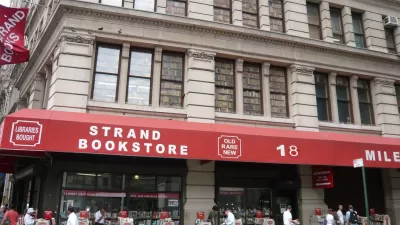In recent months many planning students have graduated and are moving on to the next phase of life—jobs, internships, fellowships, and such. For many this will involve a move to a new place. Even those staying in the same metropolitan area will seldom make it back to their planning program, and besides their fellow students will have scattered. Graduate school provides a peer group of those with similar interests and training. How do recent graduates create such a network when they are no longer in residence at a university?
In recent months many planning students have
graduated and are moving on to the next phase of life-jobs, internships,
fellowships, and such. For many this will involve a move to a new place. Even
those staying in the same metropolitan area will seldom make it back to their planning program, and besides their fellow students will have scattered. Graduate school
provides a peer group of those with similar interests and training. How do
recent graduates create such a network when they are no longer in residence at
a university? The following tips should help you start.
Join national and international organizations of planners and activists with common interests.
In an earlier posting I highlighted the work of Planners Network, the
Association for Community Design, and Architects, Designers and Planners for
Social Responsibility. There are similar small organizations in
topics from citizen participation (International Association for Public
Participation) to transportation.
Such organizations have web sites, newsletters, magazines, conferences, and other events that provide information and bring people together. While it is important to use these as places to affirm what you believe in or
who you are, I think it is also useful to find organizations that will
challenge you to be a better planner and a better person.
Join divisions of the American Planning Association (or the
equivalent where you are)-these are smaller groups that share a common interest
like transportation or new urbanism and are a good way to meet people. At one time I had been a member or all but
one or two of the APA divisions-a few new divisions have been subsequently
created so I can no longer say that. I joined a different one or two each year
including ones where I had no training and population based divisions where I
wasn't a member of that population. I didn't take a lot of airtime in those
divisions but rather tried to listen and learn. It is likely that in
one of these you'll find your niche. For members of under-represented groups
the population-based divisions of APA can be a really crucial source of support-by this
I mean the divisions Planning and the Black Community, Planning and Women, Gays
and Lesbians in Planning, Indigenous Planning, and Latinos and Planning. Students
can join divisions for $10 so they are well worth it.
Look for local groups working on an issue you believe in.
They can be useful too.
One can be in too many groups. I just left the Australian
Planning Institute where I was a corporate member (like AICP) and that I had
belonged to for more than two decades. This was mostly because I disagreed with
the way they'd implemented some membership changes and partly because one can
be in too many groups. And for much the same reason while I have a web site and
am a member of many groups I am not on Facebook, MySpace, LinkedIn or other
similar sites as faculty can be overwhelmed with requests to join networks of
this kind.
Overall, while making connections and having support are both important they are only a means to an end of doing good work. Make sure they don't get in the way of doing good planning and changing the world for the better.
I have been writing
this blog each month for almost two and a half years and have dealt with a set of issues including finding
out about planning, choosing and getting admitted to planning programs, key planning
skills, the exit project, information sources, and getting jobs. I'm looking
for new topics to cover in the next year. Suggestions for topics are welcome in the
comments area below.

Alabama: Trump Terminates Settlements for Black Communities Harmed By Raw Sewage
Trump deemed the landmark civil rights agreement “illegal DEI and environmental justice policy.”

Study: Maui’s Plan to Convert Vacation Rentals to Long-Term Housing Could Cause Nearly $1 Billion Economic Loss
The plan would reduce visitor accommodation by 25% resulting in 1,900 jobs lost.

Why Should We Subsidize Public Transportation?
Many public transit agencies face financial stress due to rising costs, declining fare revenue, and declining subsidies. Transit advocates must provide a strong business case for increasing public transit funding.

Paris Bike Boom Leads to Steep Drop in Air Pollution
The French city’s air quality has improved dramatically in the past 20 years, coinciding with a growth in cycling.

Why Housing Costs More to Build in California Than in Texas
Hard costs like labor and materials combined with ‘soft’ costs such as permitting make building in the San Francisco Bay Area almost three times as costly as in Texas cities.

San Diego County Sees a Rise in Urban Coyotes
San Diego County experiences a rise in urban coyotes, as sightings become prevalent throughout its urban neighbourhoods and surrounding areas.
Urban Design for Planners 1: Software Tools
This six-course series explores essential urban design concepts using open source software and equips planners with the tools they need to participate fully in the urban design process.
Planning for Universal Design
Learn the tools for implementing Universal Design in planning regulations.
Smith Gee Studio
Alamo Area Metropolitan Planning Organization
City of Santa Clarita
Institute for Housing and Urban Development Studies (IHS)
City of Grandview
Harvard GSD Executive Education
Toledo-Lucas County Plan Commissions
Salt Lake City
NYU Wagner Graduate School of Public Service





























